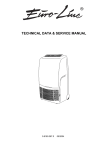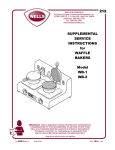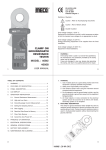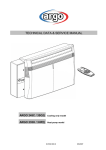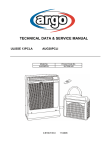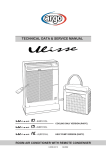Download Argo MAGICO 9.2 AMG26MIR Technical data
Transcript
TECHNICAL DATA & SERVICE MANUAL MAGICO 9.2 AMG26MIR 0.8180.469.0 07/2005 Page 3 3 4 1. SPECIFICATIONS 1-1 Unit Specifications 1-2 Major Component Specifications 6 6 2. DIMENSIONAL DATA 2-1 Unit Dimensions 7 7 3. ELECTRICAL DATA 3-1 Electric Wiring Diagram 8 8 4. REFRIGERANT FLOW DATA 4-1 Refrigerant Flow Diagram 5. FUNCTION 5-1 Cool mode operation 5-2 Dry mode operation (dehumidification) 5-3 Fan mode operation 5-4 Protection operations in cool and dry modes 5-5 Sleep function 5-6 Daily timer function 5-7 I-Feel function 5-8 Manual unit control and led indicators 5-9 Recovery from power failure 9 9 9 10 11 12 12 12 13 13 14 14 6. PERFORMANCE DATA 6-1 Performance Chart 7. TROUBLESHOOTING 7-1 Air conditioner does not operate 7-2 Some parts of air conditioners does not operate 7-3 Air conditioner operate, but abnormalities are observed 7-4 Poor cooling 7-5 Excessive cooling 7-6 If a sensor is defective 7-7 Checking electrical components 2 15 15 16 16 17 17 17 18 1. SPECIFICATIONS 1-1 Unit Specifications Power source 220 - 240 V ~ 50 Hz Voltage rating 230 V Performance Capacity (1) Efficiency (2) Air flow rate (evaporator) Air flow rate (condenser) Moisture removal Moisture removal Moisture removal Electrical ratings Available voltage range Power input Running amperes Power input Running amperes Power input Running amperes Compressor locked rotor (1) (2) W W/W m³/h m³/h l/h l/24h l/24h Hi/Me/Lo Hi/Me/Lo (3) (4) Package dimensions Weight DEHUMIDIFICATION WITHOUT AIR EXHAUSTING TUBE 2570 2,62 310 / 285 / 260 290 / 265 / 240 1,25 - - (3) (3) (4) (4) dB(A) g liters mm m mm m 260 240 27 51 198 - 264 V W A W A W A A Features Controls/Temperature controls Control unit Timer Fan speed Air Filter Operation sound Lp (5) Hi/Me/Lo Compressor Refrigerant / Amount charged at shipment Refrigerant control Water tank capacity Flexible exhaust tube I.D. extended length Hole in the window Electric cable with plug length Dimensions & Weight Unit dimensions COOLING WITH AIR EXHAUSTING TUBE 925 4,1 - 970 4,4 1090 5 18 Microprocessor / I.C. Thermostat Wireless remote control unit ON/OFF 24 hours and program 3 and auto 1 Washable 55 / 53 / 51 51 Rotary (hermetic) R410A / 590 Capillary tube ~ 3,3 115 1 138 2,9 Height mm Width mm Depth mm Height mm Width mm Depth mm Volume m³ Net kg Shipping kg Data subject to change without notice 965 530 415 1180 595 500 0,35 34 36 Rating conditions (1) Cooling indoor air temperature: 27 °C d.b. , 19 °C w.b (2) Cooling indoor air temperature: 35 °C d.b. , 24 °C w.b (3) Dehumidification indoor air temperature: 27 °C d.b. , 21 °C w.b , 60% u.r. (4) Dehumidification indoor air temperature: 30 °C d.b. , 27 °C w.b , 80% u.r. (5) Reference data: room size 100 m3 , reverberation time 0,5 s , distance 2 m Operating limits Indoor air temperature maximum Cooling 35 °C d.b. , 24 °C w.b Dehumidification 35 °C d.b. , 28 °C w.b 3 minimum 16 °C d.b. , 14 °C w.b 16 °C d.b. , 14 °C w.b 1-2 Major Component Specifications Controller PCB Controls Control circuit fuse (CE) Thermistor (coil sensor) Resistance (TH1) 25 °C NTC 10 °C ± 5% Thermistor (room sensor) Resistance (TH2) 25 °C NTC 10 °C ± 5% Fan & Fan Motor Type Q'ty ……. Dia. and lenght No. Of poles Rpm Power input (230 V) (FM) M01974 Centrifugal blower 1…. Ø 170 / L 156 4 1275/1156/1058 with flexible exhaust tube retracted 109/84/80 GRY-WHT: 87,3 ÷ 101 WHT-VLT: 36,2 ÷ 41,6 VLT-YEL: 22,8 ÷ 26,3 YEL-PNK: 22,8 ÷ 26,3 GRY-BRN: 51,9 ÷ 59,6 Thermostat 150 ± 10 Automatic mm Hi/Me/Lo speed W (Hi / Lo) Coil resistance (25°C ) Ω type Safety devices operating temp. open close °C °C (C1) µF VAC Run capacitor Float microswitch Contact rating Compressor Model Nominal input (230 V) Compressor oil Coil resistance ( 20°C) (MS) WSA Microprocessor 250 VAC - 3,15 A 3 450 up down CROUZET F83161.3 16(4) A - 250 VAC open close (CM) Rotary (hermetic) W type …. cc C-R Ω C-S Ω 5PS102EAA (R410A) 830 RB68A or Freol Alpha 68M ….. 350 3,86 ± 7% 3,30 ± 7% Data subject to change without notice 4 Safety devices Type Operating temperature Operating amperes (25 °C) (OLR) open close open with Run capacitor (compressor) °C °C (C3) µF VAC Condensate pump Model Nominal input (230 V) Winding resistance (PC) Pump relay Contact rating Coil supply Coil resistance (20 °C) (RP) W Ω Heat exchanger coil Coils Rows Fin pitch Face area Heat exchanger coil Coils Rows Fin pitch Face area 30 450 291036 5 778 ± 8% VAC kΩ H62S 5 A - 220 V 230 17,2 ± 10% mm m² EVAPORATOR COIL Aluminium fin - 3/8" Copper tube 4 1,8 0,042 mm m² 5 EXTERNAL TYPE MRA99901-9201 or MRA99437 148 ± 5 °C 69 ± 9 °C 16 A in 6 ÷ 16 s CONDENSER COIL Aluminium fin - 7mm Copper tube 5 1,3 0,084 Data subject to change without notice 2. DIMENSIONAL DATA 2-1 Unit Dimensions 6 3. ELECTRICAL DATA 3-1 Electric Wiring Diagram 4,9 COMPRESSOR CAPACITOR RECEIVER FAN MOTOR OVERLOAD PROTECTOR ELECTRONIC CONTROL ALARM LIGHT CONDENSATE PUMP PUMP RELAY ON/OFF SWITCH FLOAT MICROSWITCH ELECTRIC HEATER RELAY SENSOR RESISTANCE TERMINAL PLATE CM Cx IND FM OLRx PCB AL PC RP SW MS RR THx Rx TP 32 Legend of colors BLACK BLUE BROWN GREEN/YELLOW ORANGE RED WHITE YELLOW GREEN PINK VIOLET GREY 7 BLK BLU BRN GRN/YEL ORG RED WHT YEL GRN PNK VLT GRY 4. REFRIGERANT FLOW DATA 4-1 Refrigerant flow diagram 8 5. FUNCTION 5-1 Cool mode operation In cool mode, the operation of the compressor (COMP) and fan (FAN) are determined by the difference between the room temperature (RT) and the set point temperature (SPT) as in the graph above. notes: 1. In this graph, the FAN is operating in the "auto fan speed" setting. If the user has selected the low, medium or high fan speed, the FAN will run constantly at that speed only. 2. In addition to the value of (RT-SPT), the operations of the relays are also controlled by protection delays. For example, (a) the minimum On/Off time of the COMP is 5 min and 3 min respectively, and (b) the FAN can change speed only after it has operated at the same speed for 30 sec. 9 5-2 Dry Mode Operation (Dehumidification) In Dry Mode, the unit operates in a mild cool mode to lower the umidity of the room. In order to maintain a high efficiency in the drying operation without over lowering the room temperature excessively, the dry mode is different from the Cool Mode in two ways. 1. The FAN is forced to operate at low speed only and is turned off with the COMP. 2. The unit operates in either "dry-on" state or the "dry-off" state. If RT=SPT, the unit will operate in "dry-off" state. The COMP is forced to operate for 6 min after it has stopped working for 15 min. If RT>SPT, the unit will operate in "dry-on" state. The COMP is forced off for 3,5 min after it has been working for 15 min. Note 1: COMP is forced off in "dry-on" state. Note 2: COMP is forced to operate in "dry-off" state. 5-3 Fan Mode Operation In Fan Mode, the fan is turned on to improve the air circulation in the room. COMP remain off all the time. Note: If the user has selected the auto fan speed setting, the FAN speed would be selected by the unit automatically according to the difference between RT and SPT, as in cool mode. 10 5-4 Protection Operations in Cool and Dry Modes 1. Evaporate coil defrost protection. The evaporate coil defrost protection can prevent the ice formation at the coil when the ambient temperature is low. t1= 5 min minimum for COMP starting t2= 20 min maximum t3= COMP stop for 10 min minimum 11 5-5 Sleep Function Room temperature is automatically controlled to compensate for body temperature variations while sleeping. This mode of operation is designed for maximal comfort in COOL mode. 5-6 Daily Timer Function Unit can be programmed to be ON and OFF automatically at preset time everyday, by using a remote controller. The resolutions of the ON/OFF timers are 10 min. 5-7 I-Feel Function This feature is provided if the unit is used together with a remote controller with the I-FEEL function. When this function is selected, the remote controller sends the room temperature measured by its build-in thermistor to the aircond for more accurate temperature control. 12 5-8 Manual Unit Control and LED Indicators The push button switch and the LED indicators on the front of unit let the user to control the unit operation without a remote controller. Their operations are provided below. Led indicators: STAND BY OPERATION TIMER 1. Lights up when the air conditioner is connected to power and is ready to receive the R/C commands 2. Blinks continuosly in case of any thermistor failure 1. Lights up in operation mode (note: off in stanby mode) 2. Blinks for 0,5 sec to announce that a R/C infrared signal has been received and stored 1. Lights up during Timer and Sleep operation 2. Active on/off timer setting will become invalid after a power failure When this happens, the unit is forced to restart in STBY mode, and the timer indicator indicator is blinked continuosly until (i) the unit is switched to OPERATION mode again , or (ii) any message from the R/C is received Push button switches: OPERATION BUTTON Use to cycle the operation mode of the A/C unit among COOL and OFF modes, without using the R/C Every time this switch is pressed, the next operation mode is selected, in the order: Off mode => Cool mode => Off mode => Cool mode => ……. 5-9 Recovery from Power Failure Last unit settings (SPT, operation mode, etc) are saved in the EEPROM in the unit. In case of power failure, these settings are restored automatically. 13 6. PERFORMANCE DATA 6-1 Performance Chart 4,9 32 Operating characteristics with relative humidity around 50% Operating current (A) 5,00 4,50 4,00 3,50 3,00 2,50 18 20 22 24 26 28 30 Room temperature (°C) 14 32 34 36 7. TROUBLESHOOTING CHECK BEFORE AND AFTER TROUBLESHOOTING (A) Check power supply wiring. * WARNING: If the following troubleshooting must be done with power being supplied, be careful about any uninsulated live part that can cause ELECTRIC SHOCK. (B) Check power supply. * Check that voltage is in specified range (+/-10% of the rating) * Check that power is being supplied 7-1 Air conditioner does not operate - Circuit breaker trips (or fuse blows) - When circuit breaker is set to ON, it trips in a few moments (resetting is not possible) - Measure insulation resistance there is a possibility of ground fault. If resistance value is 1 Mohm or less, insulation is defective - Circuit breaker trips in several minutes after turning air conditioner ON - There is a possibility of short circuit - Unit not run Power is not supplied Check fuse on PCB assy 15 7-2 Some parts of air conditioner does not operate - Only fan does not run - Only compressor motor does not run 7-3 Air conditioner operate, but abnormalities are observed - Check remote control unit - Check fuse on PCB assy 16 7-4 Poor cooling 7-5 Excessive cooling 7-6 If a sensor is defective - TH1 (coil sensor) TH2 (room ambient teperature) are defective NOTE: Alarm signal (*) Standby lamp, on front side of the unit, will blink when the thermistor is defective. At the same time the unit operate only for ventilation. 17 7-7 Checking electrical components - Measurement of insulation resistance The insulation is in good condition if the resistence exceedes 1 MOhm a) power supply wires Clamp the earthed wire of the power supply wires with the lead clip of the insulation resiatance tester and measure the resistance by placing a probe on either of the power wires (fig.1). Then measure the resistance between the earthed wire and the other power wires (fig.1). Clamp an alluminium plate fin or copper tube with the lead clip of the insulation resistance tester and measure the resistance by placing a probe on N terminal, and then on L terminal in the terminal plate (fig.2). b) measurement of insulation resistance for electrical parts Disconnect the lead wires of the desired electrical part from terminal plate, PCB assy, capacitor, etc. Similarly disconnect the connector, then measure the insulation resistance (fig.1 to 4). Refer to electric wiring diagram. - Checking continuity of fuse on PCB assy Remove PCB assy from electrical component box (fig.5), then pull out the fuse from PCB assy. Check continuity of fuse by the multimeter (fig.6). - Checking motor capacitor Remove the lead wires from the capacitor terminals, and then place a probe on the capacitor terminals as shown in fig.7. Observe the deflection of the pointer, setting the resistance measuring range of the multimeter to the maximum value. The capacitor is "good" if the pointer bounces to a great extent and the gradually returns to its original position. The range of deflection and deflection time deffer according to capacity of the capacitor. 18 Via Varese, 90 - 21013 Gallarate - Va - Italy Tel. +39 0331 755111 - Fax +39 0331 776240 www.argoclima.it



















